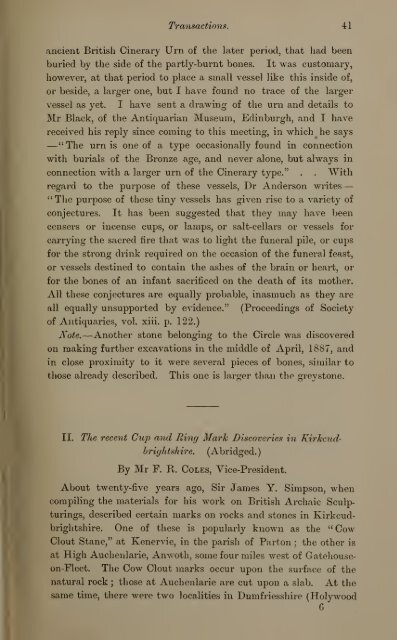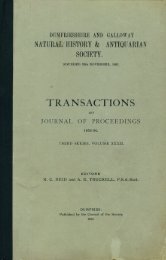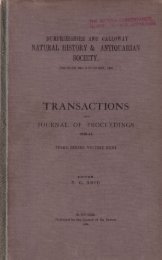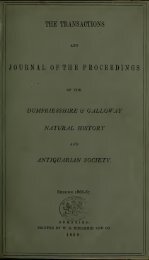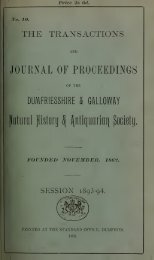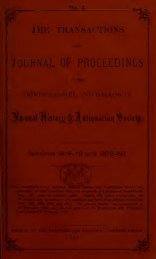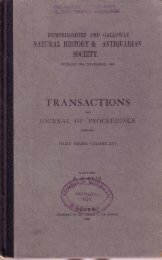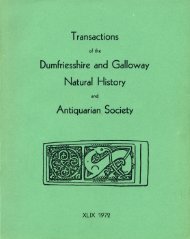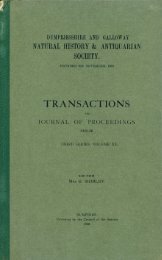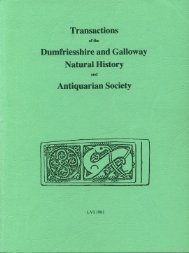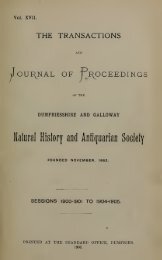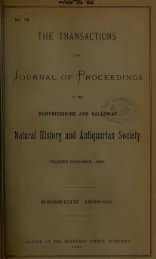Vol 5 - Dumfriesshire & Galloway Natural History and Antiquarian ...
Vol 5 - Dumfriesshire & Galloway Natural History and Antiquarian ...
Vol 5 - Dumfriesshire & Galloway Natural History and Antiquarian ...
Create successful ePaper yourself
Turn your PDF publications into a flip-book with our unique Google optimized e-Paper software.
—Transactions. 41ancient British Cinerary Urn of the later period, that had beenburied by the side of the partly-burnt bones.It was customary,however, at that period to place a small vessel like this inside of,or beside, a larger one, but I have found no trace of the largervessel as yet. I have sent a drawing of the urn <strong>and</strong> details toMr Black, of the <strong>Antiquarian</strong> Museum, Edinburgh, <strong>and</strong> I havereceived his reply since coming to this meeting, in which he says— " The urn is one of a type occasionally found in connectionwith burials of the Bronze age, <strong>and</strong> never alone, but always inconnection with a larger urn of the Cinerary type." . . Withregard to the purpose of these vessels, Dr Anderson writes" The purpose of these tiny vessels has given rise to a variety ofconjectures. It has been suggested that tiiey may have beencensers or incense cups, or lamps, or sali>cellars or vessels forcarrying the sacred fire that was to light the funeral pile, or cupsfor the strong drink required on the occasion of the funeral feast,or vessels destined to contain the ashes of the brain or heart, orfor the bones of an infant sacrificed on the death of its mother.All these conjectures are equally probable, inasmuch as they areall equally unsupported by evidence." (Proceedings of Societyof Antiquai'ies, vol. xiii. p. 122.)JVote.—Another stone belonging to the Circle was discoveredon making further excavations in the middle of April, 1887, <strong>and</strong>in close proximity to it were several pieces of bones, similar tothose already described.This one is larger than the greystone.II.The recent Cup <strong>and</strong> Ring Mark Discoveries in Kirkcudbrightshire.(Abridged.)By Mr F. R. Coles, Vice-President.About twenty-five years ago, Sir James Y. Simpson, whencompiling the materials for his work on British Archaic Sculpturings,described certain marks on rocks <strong>and</strong> stones in Kirkcudbrightshire.One of these is popularly known as the "CowClout Stane," at Kenervie, in the parish of Parton ; the other isat High Auchenlarie, AnAvoth, some four miles west of Gatehouseon-Fleet.The Cow Clout marks occur upon the surface of thenatural rock ; those at Auchenlarie are cut upon a slab. At thesame time, there were two localities in <strong>Dumfriesshire</strong> (Holywood


